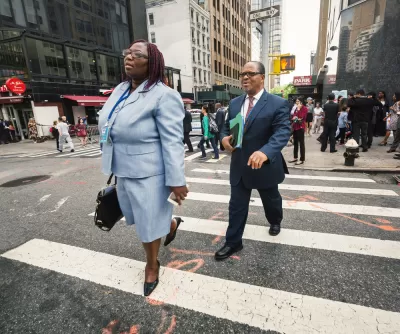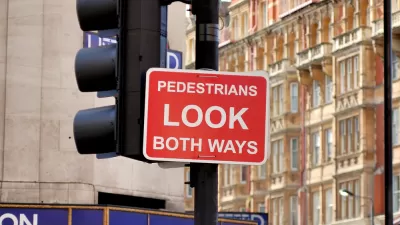Pedestrians of color are more likely to be killed in traffic crashes.

Traffic fatalities have been rising overall across the United States, and the percentage of pedestrians killed is growing. But the impact of these trends is not evenly felt across demographics: Pedestrians of color are more likely to be killed in traffic.
NPR's Morning Edition explores a study in Las Vegas that found that cars were less likely to stop for a black pedestrian than a white one crossing the street—suggesting that driver bias is a real factor in the racial distribution of traffic fatalities.
Correspondent Shankar Vedantam says researchers have been aware of this issue for "quite some time," and there's more research to be done. A larger study could yield additional reasons for the disparity—for instance, "that people of color are just more likely to be pedestrians." When that factor is controlled for, another could be that "minority neighborhoods have less safe traffic intersections"—making a case for focusing on racial equity in transportation planning.
FULL STORY: Researchers Examine Race Factor In Car Crashes Involving Pedestrians

Study: Maui’s Plan to Convert Vacation Rentals to Long-Term Housing Could Cause Nearly $1 Billion Economic Loss
The plan would reduce visitor accommodation by 25,% resulting in 1,900 jobs lost.

North Texas Transit Leaders Tout Benefits of TOD for Growing Region
At a summit focused on transit-oriented development, policymakers discussed how North Texas’ expanded light rail system can serve as a tool for economic growth.

Why Should We Subsidize Public Transportation?
Many public transit agencies face financial stress due to rising costs, declining fare revenue, and declining subsidies. Transit advocates must provide a strong business case for increasing public transit funding.

How to Make US Trains Faster
Changes to boarding platforms and a switch to electric trains could improve U.S. passenger rail service without the added cost of high-speed rail.

Columbia’s Revitalized ‘Loop’ Is a Hub for Local Entrepreneurs
A focus on small businesses is helping a commercial corridor in Columbia, Missouri thrive.

Invasive Insect Threatens Minnesota’s Ash Forests
The Emerald Ash Borer is a rapidly spreading invasive pest threatening Minnesota’s ash trees, and homeowners are encouraged to plant diverse replacement species, avoid moving ash firewood, and monitor for signs of infestation.
Urban Design for Planners 1: Software Tools
This six-course series explores essential urban design concepts using open source software and equips planners with the tools they need to participate fully in the urban design process.
Planning for Universal Design
Learn the tools for implementing Universal Design in planning regulations.
Ascent Environmental
Borough of Carlisle
Institute for Housing and Urban Development Studies (IHS)
City of Grandview
Harvard GSD Executive Education
Toledo-Lucas County Plan Commissions
Salt Lake City
NYU Wagner Graduate School of Public Service



























